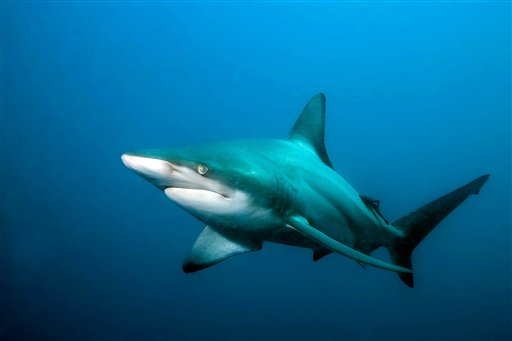
Scientists have confirmed the second case of a
”
virgin birth
”
in a shark.
Scientists have confirmed the second case of a “virgin birth” in a shark.
In a study reported Friday in the Journal of Fish Biology, scientists said DNA testing proved that a pup carried by a female Atlantic blacktip shark in the Virginia Aquarium & Marine Science Center contained no genetic material from a male.
The first documented case of asexual reproduction, or parthenogenesis, among sharks involved a pup born to a hammerhead at an Omaha, Nebraska, zoo.
“This first case was no fluke,” Demian Chapman, a shark scientist and lead author of the second study, said in a statement. “It is quite possible that this is something female sharks of many species can do on occasion.”
The aquarium sharks that reproduced without mates each carried only one pup, while some shark species can produce litters numbering in the dozen or more. The scientists cautioned that the rare asexual births should not be viewed as a possible solution to declining global shark populations.
“It is very unlikely that a small number of female survivors could build their numbers up very quickly by undergoing virgin birth,” Chapman said.
The medical mystery began 16 months ago after the death of the Atlantic blacktip shark named Tidbit at the Virginia Beach aquarium. No male blacktip sharks were present during her eight years at the aquarium.
In May 2007, the 5-foot (1.52-meter), 94-pound (43-kilogram) shark died of stress-related complications related to her unknown pregnancy after undergoing a yearly checkup. The 10-inch (25.4-centimeter) shark pup was found during a necropsy of Tidbit, surprising aquarium officials. They initially thought the embryonic pup was either a product of a virgin birth or a cross between the blacktip and a male of another shark species – which has never been documented, Chapman said.
Tidbit’s pup was nearly full term, and likely would have been quickly eaten by “really big sand tiger sharks” that were in the tank, Chapman said in a telephone interview from Florida.
That is what happened to the tiny hammerhead pup in the Omaha case.
“By the time they could realize what they were looking at, something munched the baby,” he said of aquarium workers. The remains of the pup were used for the DNA testing.
Virgin birth has been proven in some bony fish, amphibians, reptiles and birds, and has been suspected among sharks in the wild. The scientists who studied the Virginia and Nebraska sharks said the newly formed pups acquired one set of chromosomes when the mother’s chromosomes split during egg development, then united anew.
Absent the chromosomes present in the male sperm, the offspring of an asexual conception have reduced genetic diversity and, the scientists said, may be at a disadvantage for surviving in the wild. A pup, for instance, can be more susceptible to congenital disorders and diseases.
The scientists said their findings offer “intriguing questions” about how frequently automictic parthenogenesis occurs in the wild.
“It is possible that parthenogenesis could become more common in these sharks if population densities become so low that females have trouble finding mates,” said Mahmood Shivji, one of the scientists and director of the Guy Harvey Research Institute at Nova Southeastern University in Florida.
The DNA fingerprinting techniques used by the scientists are identical to those used in human paternity testing.









